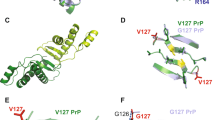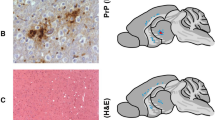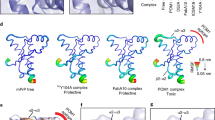Abstract
Mammalian prions, transmissible agents causing lethal neurodegenerative diseases, are composed of assemblies of misfolded cellular prion protein (PrP)1. A novel PrP variant, G127V, was under positive evolutionary selection during the epidemic of kuru—an acquired prion disease epidemic of the Fore population in Papua New Guinea—and appeared to provide strong protection against disease in the heterozygous state2. Here we have investigated the protective role of this variant and its interaction with the common, worldwide M129V PrP polymorphism. V127 was seen exclusively on a M129 PRNP allele. We demonstrate that transgenic mice expressing both variant and wild-type human PrP are completely resistant to both kuru and classical Creutzfeldt–Jakob disease (CJD) prions (which are closely similar) but can be infected with variant CJD prions, a human prion strain resulting from exposure to bovine spongiform encephalopathy prions to which the Fore were not exposed. Notably, mice expressing only PrP V127 were completely resistant to all prion strains, demonstrating a different molecular mechanism to M129V, which provides its relative protection against classical CJD and kuru in the heterozygous state. Indeed, this single amino acid substitution (G→V) at a residue invariant in vertebrate evolution is as protective as deletion of the protein. Further study in transgenic mice expressing different ratios of variant and wild-type PrP indicates that not only is PrP V127 completely refractory to prion conversion but acts as a potent dose-dependent inhibitor of wild-type prion propagation.
This is a preview of subscription content, access via your institution
Access options
Subscribe to this journal
Receive 51 print issues and online access
$199.00 per year
only $3.90 per issue
Buy this article
- Purchase on Springer Link
- Instant access to full article PDF
Prices may be subject to local taxes which are calculated during checkout

Similar content being viewed by others
References
Collinge, J. Prion diseases of humans and animals: their causes and molecular basis. Annu. Rev. Neurosci. 24, 519–550 (2001).
Mead, S. et al. A novel protective prion protein variant that colocalizes with kuru exposure. N. Engl. J. Med. 361, 2056–2065 (2009).
Jucker, M. & Walker, L. C. Self-propagation of pathogenic protein aggregates in neurodegenerative diseases. Nature 501, 45–51 (2013).
Collinge, J., Palmer, M. S. & Dryden, A. J. Genetic predisposition to iatrogenic Creutzfeldt-Jakob disease. Lancet 337, 1441–1442 (1991).
Palmer, M. S., Dryden, A. J., Hughes, J. T. & Collinge, J. Homozygous prion protein genotype predisposes to sporadic Creutzfeldt-Jakob disease. Nature 352, 340–342 (1991).
Collinge, J. Molecular neurology of prion disease. J. Neurol. Neurosurg. Psychiatry 76, 906–919 (2005).
Mead, S. et al. Balancing selection at the prion protein gene consistent with prehistoric kuru-like epidemics. Science 300, 640–643 (2003).
Antonyuk, S. V. et al. Crystal structure of human prion protein bound to a therapeutic antibody. Proc. Natl Acad. Sci. USA 106, 2554–2558 (2009).
Collinge, J. Variant Creutzfeldt-Jakob disease. Lancet 354, 317–323 (1999).
Collinge, J. & Clarke, A. A general model of prion strains and their pathogenicity. Science 318, 930–936 (2007).
Shibuya, S., Higuchi, J., Shin, R. W., Tateishi, J. & Kitamoto, T. Protective prion protein polymorphisms against sporadic Creutzfeldt-Jakob disease. Lancet 351, 419 (1998).
Asante, E. A. et al. BSE prions propagate as either variant CJD-like or sporadic CJD-like prion strains in transgenic mice expressing human prion protein. EMBO J. 21, 6358–6366 (2002).
Asante, E. A., Li, Y. G., Gowland, I., Jefferys, J. G. & Collinge, J. Pathogenic human prion protein rescues PrP null phenotype in transgenic mice. Neurosci. Lett. 360, 33–36 (2004).
Wadsworth, J. D. et al. Human prion protein with valine 129 prevents expression of variant CJD phenotype. Science 306, 1793–1796 (2004).
Wadsworth, J. D., Asante, E. A. & Collinge, J. Contribution of transgenic models to understanding human prion disease. Neuropathol. Appl. Neurobiol. 36, 576–597 (2010).
Collinge, J. et al. Unaltered susceptibility to BSE in transgenic mice expressing human prion protein. Nature 378, 779–783 (1995).
Hill, A. F. et al. The same prion strain causes vCJD and BSE. Nature 389, 448–450 (1997).
Asante, E. A. et al. Dissociation of pathological and molecular phenotype of variant Creutzfeldt-Jakob disease in transgenic human prion protein 129 heterozygous mice. Proc. Natl Acad. Sci. USA 103, 10759–10764 (2006).
Wadsworth, J. D. et al. Kuru prions and sporadic Creutzfeldt-Jakob disease prions have equivalent transmission properties in transgenic and wild-type mice. Proc. Natl Acad. Sci. USA 105, 3885–3890 (2008).
Collinge, J., Sidle, K. C., Meads, J., Ironside, J. & Hill, A. F. Molecular analysis of prion strain variation and the aetiology of 'new variant' CJD. Nature 383, 685–690 (1996).
Bruce, M. E. et al. Transmissions to mice indicate that 'new variant' CJD is caused by the BSE agent. Nature 389, 498–501 (1997).
Perrier, V. et al. Dominant-negative inhibition of prion replication in transgenic mice. Proc. Natl Acad. Sci. USA 99, 13079–13084 (2002).
Hizume, M. et al. Human prion protein (PrP) 219K is converted to PrPSc but shows heterozygous inhibition in variant Creutzfeldt-Jakob disease infection. J. Biol. Chem. 284, 3603–3609 (2009).
Striebel, J. F., Race, B., Meade-White, K. D., LaCasse, R. & Chesebro, B. Strain specific resistance to murine scrapie associated with a naturally occurring human prion protein polymorphism at residue 171. PLoS Pathog. 7, e1002275 (2011).
DiSalvo, S., Derdowski, A., Pezza, J. A. & Serio, T. R. Dominant prion mutants induce curing through pathways that promote chaperone-mediated disaggregation. Nature Struct. Mol. Biol. 18, 486–492 (2011).
Büeler, H. et al. Mice devoid of PrP are resistant to scrapie. Cell 73, 1339–1347 (1993).
Alpers, M. P. The epidemiology of kuru: monitoring the epidemic from its peak to its end. Phil. Trans. R. Soc. Lond. B 363, 3707–3713 (2008).
Hill, A. F. et al. Molecular classification of sporadic Creutzfeldt-Jakob disease. Brain 126, 1333–1346 (2003).
Asante, E. A. et al. Absence of spontaneous disease and comparative prion susceptibility of transgenic mice expressing mutant human prion proteins. J. Gen. Virol. 90, 546–558 (2009).
Wadsworth, J. D. et al. Molecular diagnosis of human prion disease. Methods Mol. Biol. 459, 197–227 (2008).
Acknowledgements
This work was funded by the UK Medical Research Council. We thank all staff at our Biological Services Facility for animal care; C. O’Malley and S. Lyall for technical support with histology; and R. Newton and R. Young for preparation of figures. We thank patients and families for consent to use human tissues. We thank UK neurological and neuropathology colleagues for providing brain tissue from CJD patients. Some of this work was undertaken at University College London Hospitals/University College London, which received a proportion of funding from the Department of Health's National Institute for Health Research Biomedical Research Centres funding scheme. We thank the Fore communities and P. Siba and colleagues at the Papua New Guinea Institute of Medical Research for their long-term support. We thank the late C. Gajdusek, the late J. Gibbs, S. Landis, and their associates from the Laboratory of Central Nervous System Studies of the National Institutes of Health, Bethesda, USA, for archiving and sharing kuru samples.
Author information
Authors and Affiliations
Contributions
E.A.A., J.D.F.W. and J.C. conceived and designed the study. M.S. and E.A.A. cloned the transgene constructs. R.H., A.T. and A.J. generated and developed transgenic lines. M.S., T.J., S.H. and E.A.A. analysed and characterized the transgenic mice. A.G. analysed prion-infected mouse brains by immunoblotting. A.R.-L., J.M.L. and S.B. performed histological analyses and interpreted the pathology data. S.M., J.W., J.D.F.W. and M.A. characterized CJD cases and inocula. E.A.A. supervised the study and collated data. E.A.A., J.D.F.W. and J.C. drafted the paper with contributions from all authors.
Corresponding author
Ethics declarations
Competing interests
J.C. is a Director and J.C. and J.D.F.W. are shareholders of D-Gen Limited, an academic spin-out company in the field of prion diagnosis, decontamination and therapy. D-Gen supplied the ICSM 35 antibody used in this study.
Extended data figures and tables
Extended Data Figure 1 Immunoblots showing relative PrPC expression levels in transgenic mice.
The provenance of each brain sample is designated above each lane and molecular markers are indicated on the left. The PRNP codon 127 (G, glycine, V, valine) or codon 129 (M, methionine, V, valine) genotypes of the transgenic mice are designated below. Transgenic mouse brains were analysed by enhanced chemiluminescence without proteinase-K digestion and equal amounts of total protein loaded in each well and probed with anti-PrP monoclonal antibody ICSM 35. Wild-type human PrP expression levels of G127M129/G127M129 Tg35c and G127V129/G127V129 Tg152c mice are two- and sixfold higher, respectively, than seen in 10% (w/v) pooled human brain homogenate. Homozygous V127M129 Tg183 and Tg190 mice have twofold higher or equivalent PrP expression levels, respectively, compared to 10% (w/v) pooled human brain homogenate.
Extended Data Figure 2 Immunohistochemical analysis of transgenic mouse brain following challenge with vCJD prions.
All mice were intracerebrally challenged with the same vCJD prion isolates (I342 and I7042). Abnormal PrP deposition in fixed post-mortem brain from affected mice was detected using anti-PrP monoclonal antibody ICSM 35. a, b, Homozygous Tg35c mice (expressing G127M129/G127M129 wild-type PrP only) show intense and widespread PrP plaque deposits. Magnified areas show hippocampus (a, panel i), frontal cortex (b, panel i) and thalamus (a, panel ii, and b, panel ii). c, d, In contrast, heterozygous G127M129/V127M129 Tg35c/Tg183 mice expressing equivalent levels of G127M129 and V127M129 PrP show only weak PrP deposition in the corpus callosum (c, panel i, and d, panel i) with no abnormal PrP deposition detected in other brain areas, for example, in the thalamus (c, panel ii, and d, panel ii). e, f, Heterozygous G127M129/V127M129 Tg35c/Tg190 mice which express a lower level of V127M129 PrP relative to wild-type G127M129 PrP show greater levels of PrP deposition than seen in Tg35c/Tg183 mice following challenge with the same vCJD prion isolates. e (panels i and ii) and f (panel i), corpus callosum; f (panel ii), pons. Scale bar: upper panels, 2 mm; magnified panels, 100 µm.
Extended Data Figure 3 Immunohistochemical analysis of homozygous PRNP V127M129/V127M129 transgenic mouse brain following challenge with human prions.
Mice were intracerebrally challenged with kuru, classical and variant CJD prions. Following prolonged (>600 days) post-inoculation periods, abnormal PrP deposition in fixed post-mortem brain was examined using anti-PrP monoclonal antibody ICSM 35. a–d, V127M129/V127M129 Tg183 mice with twofold overexpression of V127M129 PrP. e–h, V127M129/V127M129 Tg190 mice expressing endogenous levels of V127M129 PrP. Red square boxes in the main panels (a–h) define the area of magnified images of hippocampus (panel i) and thalamus (panel ii) shown in the lower panels. Scale bars, 2 mm; magnified panels i and ii, 100 μm. The lack of detection of abnormal PrP deposition in brain indicates that the mice are not subclinically infected with prions.
Extended Data Figure 4 Schematic diagram summarizing transmissions of kuru and classical CJD prions to transgenic mice expressing human PrP.
G127M129/G127M129 Tg35c mice or G127V129/G127V129 Tg152c mice are homozygous for wild-type human PrP alleles and are fully susceptible to kuru and classical CJD prions. V127M129/V127M129 Tg183 or V127M129/V127M129 Tg190 transgenic mice are homozygous for the variant V127M129 allele found only in humans from the kuru-exposed population of Papua New Guinea and are entirely resistant to infection with kuru and classical CJD prions. The levels of PrP expression in the brain of these homozygous transgenic mice relative to a pooled human brain homogenate are 1× (Tg190 mice), 2× (Tg35c and Tg183 mice) and 6× (Tg152c mice). Generation of F1 mice through inter-breeding the various homozygous lines produces different combinations of the various human PrP alleles leading to differences in the relative expression levels of the various prion proteins in brain. The PrP expression ratios from the two PrP alleles in the crosses are shown in parentheses above the mouse sketches. Full, intermediate or low susceptibility of the mice to infection with kuru and classical CJD prions is indicated by three, two or one diagonal red bar, respectively, drawn across the mice. Mice with no red bar are entirely resistant to infection with kuru and classical CJD prions.
Extended Data Figure 5 Immunohistochemical analysis of homozygous PRNP G127V129/G127V129 and heterozygous G127V129/V127M129 transgenic mouse brain following challenge with human prions.
Mice were intracerebrally challenged with kuru and classical CJD prions, and abnormal PrP deposition in fixed post-mortem brain from affected mice was examined using anti-PrP monoclonal antibody ICSM 35. Red square boxes labelled i and ii in panels a–f mark brain areas that are magnified and displayed below; i, cortex; ii, thalamus. a, b, Wild-type G127V129/G127V129 Tg152c mice. c, d, Heterozygous G127V129/V127M129 Tg152c/Tg183 mice. e, f, Heterozygous G127V129/V127M129 Tg152c/190 mice. Scale bars, 2 mm; magnified panels i and ii, 100 μm. The detection of abnormal PrP deposition in brain indicates that the mice are infected with prions.
PowerPoint slides
Rights and permissions
About this article
Cite this article
Asante, E., Smidak, M., Grimshaw, A. et al. A naturally occurring variant of the human prion protein completely prevents prion disease. Nature 522, 478–481 (2015). https://doi.org/10.1038/nature14510
Received:
Accepted:
Published:
Issue Date:
DOI: https://doi.org/10.1038/nature14510
This article is cited by
-
A structural basis for prion strain diversity
Nature Chemical Biology (2023)
-
Prion assemblies: structural heterogeneity, mechanisms of formation, and role in species barrier
Cell and Tissue Research (2023)
-
Organoids for modeling prion diseases
Cell and Tissue Research (2023)
-
Estimation of the number of inherited prion disease mutation carriers in the UK
European Journal of Human Genetics (2022)
-
Overexpression of mouse prion protein in transgenic mice causes a non-transmissible spongiform encephalopathy
Scientific Reports (2022)
Comments
By submitting a comment you agree to abide by our Terms and Community Guidelines. If you find something abusive or that does not comply with our terms or guidelines please flag it as inappropriate.



